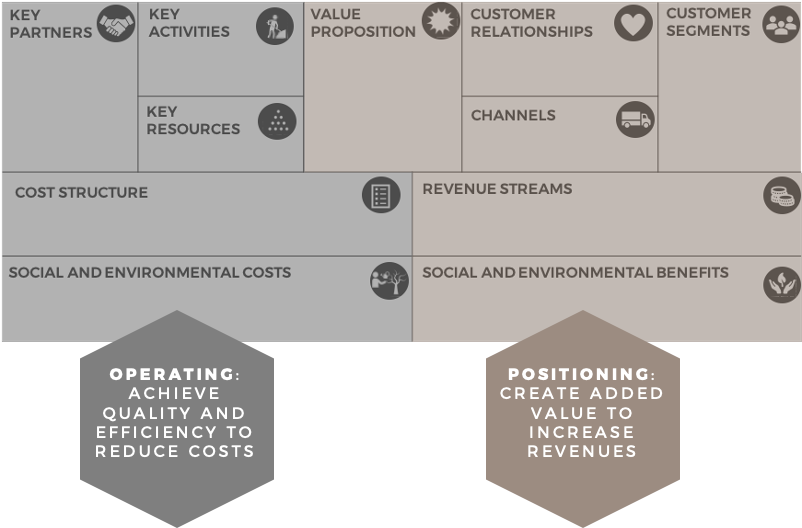Executive Summary
A business model is not to be confused with a business plan or business strategy. Before rolling out your business idea or writing a business plan for convincing financing partners to invest in your business, you need to be clear about your business model. Essentially it is the architecture or the design of the business that the business plan and strategy are built on.
Introduction
The business model describes the logic of how a business creates and delivers added value for a specific customer segment, and how the business captures value for itself. So in other words, it depicts how the business can operate sustainably in the long-run. This factsheet describes the main components of the business model.
The Business Model Canvas
There are many ways to blueprint a business model. We recommend using the business model canvas adapted from Osterwalder & Pigneur (2009). It is a handy and dynamic tool that allows blueprinting a business model on a one page overview by describing these 11 building blocks:
- on the right hand side: customer segments, value propositions, customer relationships, channels, revenue streams as well as the benefits of the business for society and the environment.
- on the left hand side: key activities, key resources, key partners, cost structure as well as the costs of the business for society and the environment.

The business model canvas. Adapted from: OSTERWALDER & PIGNEUR 2009
The right hand side of the canvas describes how the business is positioned in the market and the added value it creates. The left hand side of the canvas describes how the business is operated and how quality and efficiency are achieved in operations.
Whether the goal is to maximize profits, to break-even, or recover or save costs, or simply do good for people and planet, a business needs to gain competitive advantage - so perform better than existing solutions or products - to attain and defend market share. To increase revenues, you want to get customers to switch onto or stay with your product, so you need to offer them more added value than the competition. To reduce costs, you want to make sure that you operate efficiently while maintaining the right level of quality for the product or service.
There are eleven building blocks in a business model canvas:
Customer Segments (CS)
Customers are at the heart of your business model. Without paying customers you are out of business. To be successful in the market, you need to design products that actually fit your customers’ needs.
Customer segments defines the different groups of people or organisations an enterprise aims to reach and serve. The Customer Segments can be broken down into sub-segments if their needs require and justify a distinct offer (e.g. they are reached through different channels, they require different types of relationships, they have substantially different profitabilities, or they are willing to pay for different aspects of the offer).
Value Propositions (VP)
The value proposition describes:
- Your product or service: What is your product or service and how can it contribute to covering customer activities? When describing the actual product also mention the need and any add-on services. The Value Propositions may be quantitative (e.g. price, speed of service) or qualitative (e.g. design, customer experience).
- Your pain alleviators: How does your product or service alleviate your customers’ pains? To make the value proposition unique and easily differentiate it from the competition, mention any special features or aspects and the added value that your customer gets from using your products. This added value is described through a number of attributes that respond to the customers’ needs; such as customization, higher performance (“getting the job done”), better brand and reputation, different design, newness, lower price, cost and risk reduction, better accessibility, as well as more convenience.
Channels (CH)
The channels determine how you interact with your customers. Keep in mind though that you are not only interacting with your customer for the actual sale of the product. Consider all the phases where the customer experiences your business:
- Awareness: Where do you raise awareness about your product or service?
- Sale: Where do customers purchase your product or service?
- Delivery: Where do you deliver the product or service to your customers?
- After sales: Where do you provide after-sales support to your customers?
- Evaluation: Where can customers evaluate your business?
Customer Relationships (CR)
Customer relationships define how closely you interact with your customers and how much you respond to their individual needs by coming up with customized solutions. The relationships you establish with your customers will deeply impact the customer experience and will have an influence on their trust and willingness to switch to your product and become a loyal customer to your business.
Revenue Streams (RS)
The Revenue Stream describes how a company will generate cash from each Customer Segment. The Revenue Stream has to take into account how much customers will be willing to pay for the value the company delivers. There are two basic types of revenue stream: revenues from one-time customer payments, and recurring revenues from on-going payments.
Social and Environmental Benefits (SEB)
Social and environmental benefits are the external benefits that the business produces for society and the environment. Careful consideration of these benefits is important to position yourself as a business with a positive social and environmental impact can create an avenue for justifying financial support from governments, donors or impact investors.
Key Activities (KA)
The Key Activities describe the most important things a company must do to make its business model work. They can be activities to create and offer Value Propositions, reach markets, maintain Customer Relationships, and earn revenues. These are the activities that you need to perform well because they are essential to operating your business. The more resource-intensive the production of the value proposition, the more comprehensive the channels, the more personal the customer relationships, the longer the list of activities will be.
Key Resources (KR)
The Key Resources describes the most important assets within a company that make a business model work. These generally include physical resources (e.g. buildings, vehicles, etc.), intellectual resources (e.g. brands, partnerships, proprietary knowledge, etc.), human resources (e.g. employees), and financial resources (e.g. cash, lines of credit, etc.). Decide which resources you absolutely need to own (in-house resources) and which ones can be rented or used by building strategic partnerships. The less in-house resources are needed, the lower the investment costs will be.
Key Partnerships (KP)
The Key Partnerships describes the network of suppliers and partners that make a business model work. These are institutions or individuals that have resources that you don’t have or that perform activities better, faster or cheaper than you. Partnerships can generally be categorised into: strategic alliances between non-competitors, strategic partnership between competitors, joint ventures to develop new businesses, and buyer-supplier relationships. The importance of forming partnerships is evident, but partnership management also requires time, so only create partnerships that clearly add value to your business model.
Cost Structure (CS)
The Cost Structure describes all costs incurred to operate a business model and their percentages of total costs. It is essential to get a realistic understanding of these costs and which components of the business model drive your costs up the most.
Social and Environmental Costs (SEC)
Social and environmental costs differ from your business’ operating costs. These are external costs resulting from your activities that impact the environment and society. You have to take these potential costs into account when designing your business model and mitigate them as these have monetary and legal implications for the overall sustainability of your business.
How to Use the Business Model Canvas
- Draw the business model canvas on a large sheet of paper. Use different coloured post-its to fill in the building blocks of the canvas.
- Start with the different Customer Segments and the Value Propositions your company offers to them. The colour you use for the Value Propositions should correspond to their respective Customer Segments.
- Once Customer Segments and Value Propositions are filled in, complete the remaining elements for the positioning of the business: Channels, Customer Relationships and Revenue Streams. If you have specific ones for each Customer Segment, make sure to use the same colour. For example, in the above business model example blue and orange cards were used to distinguish between two distinct Customer Segments that have clearly different Value Propositions, Customer Relationships, Channels, Revenue Streams and Social and Environmental Benefits.
- Then proceed to fill in the operational side of the business model canvas: the Key Activities, Key Resources, Key Partnerships, Cost Structure and Social and Environmental Costs.
- Once done, use the canvas to understand and analyse your business model and adapt if necessary.
Business Model Generation
http://www.businessmodelgeneration.com/
As the official website of Business Model Generation by Osterwalder & Pigneur, this website offers guidance and resources for making use of the business model template.
http://www.businessmodelgeneration.com/
Download a pdf of the business model canvas from Business Model Generation by Osterwalder & Pigneur here.
http://bmimatters.com/
This blog entry from BMI Matters takes readers step by step through understanding the business models of well-known companies like LinkedIn and Google by fitting them within the business model template.
cewas - The business and integrity experts in the water sector
cewas is a Swiss-based international centre of competence in the field of sustainable sanitation and water resource management. It combines advanced education with a start-up centre, a think tank, and a business platform.


